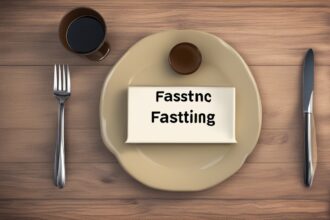Hey there, health enthusiasts! If you’ve ever wondered, “What exactly is fasting?” or how it can impact your body and mind, you’re in the right place. Fasting, a practice as old as humanity itself, has surged in popularity thanks to its potential health benefits and simplicity. Whether you’re curious about intermittent fasting, water fasting, or just want the basics of fasting explained, this guide will break it down for you. We’ll dive into the science, explore different types, and share practical tips to help you decide if fasting is right for you. Let’s get started on this journey to understanding fasting and how it might transform your approach to wellness!
What is Fasting? The Basics Explained
At its core, fasting is the voluntary act of abstaining from food and, in some cases, drink for a specific period. It’s not about starvation but rather giving your body a break from constant digestion. Historically, fasting has been part of religious and cultural traditions across the globe, from Ramadan in Islam to Lent in Christianity. Today, it’s often approached as a health strategy. When we talk about fasting explained in modern terms, it usually involves structured eating windows or prolonged periods without calories to trigger specific physiological responses. Think of it as hitting the reset button on your metabolism.
The primary goal of fasting isn’t just weight loss, though that’s a common motivator. It’s about tapping into your body’s natural processes, like autophagy—a cellular cleanup mechanism that kicks in during extended fasts (Levine & Kroemer, 2019). Whether you’re exploring fasting for health, spiritual reasons, or curiosity, understanding the ‘why’ and ‘how’ is key to doing it safely and effectively.
The Science Behind Fasting: How It Works
Let’s get a little nerdy and unpack the science of fasting. When you eat, your body breaks down food into glucose for energy, storing excess as glycogen in your liver and muscles. Once you stop eating, your body taps into these reserves. After about 12–16 hours without food, glycogen stores deplete, and your body shifts to burning fat for fuel—a state called ketosis (Anton et al., 2018). This metabolic switch is why fasting is often linked to fat loss and improved energy.
Beyond ketosis, fasting triggers other fascinating changes. It can lower insulin levels, improve insulin sensitivity, and reduce inflammation—factors tied to chronic diseases like diabetes and heart disease (de Cabo & Mattson, 2019). Plus, as mentioned earlier, autophagy ramps up during longer fasts, helping your cells recycle damaged components. It’s like a deep clean for your body at the microscopic level! While the research is promising, scientists are still exploring long-term effects, so it’s wise to approach fasting with balance and caution.
Different Types of Fasting: Finding What Works for You
Not all fasting is created equal, and that’s a good thing—it means there’s likely a style that fits your lifestyle. When diving into fasting explained, it’s helpful to know the main types and how they differ. Here are some of the most popular approaches:
- Intermittent Fasting (IF): This involves cycling between eating and fasting windows. The 16/8 method (fast for 16 hours, eat during an 8-hour window) is a favorite for beginners.
- Water Fasting: You consume only water for 24–72 hours or more. It’s intense and should only be done under medical supervision for extended periods.
- Alternate-Day Fasting: Eat normally one day, then restrict calories (or fully fast) the next. It’s effective but can be tough to sustain.
- 5:2 Diet: Eat normally for five days of the week, then limit to 500–600 calories on two non-consecutive days. It’s less restrictive than daily fasting.
Each method has its perks and challenges, so experiment to see what aligns with your goals and daily routine. Remember, fasting isn’t a one-size-fits-all deal—what works for your friend might not work for you.
Potential Benefits of Fasting: What the Research Says
Now that we’ve got the basics of fasting explained, let’s talk about why so many people swear by it. The potential benefits are backed by a growing body of research, though results can vary from person to person. Fasting isn’t a magic bullet, but it does show promise in several areas. For instance, studies suggest it can support weight management by reducing overall calorie intake and boosting fat-burning (Johnstone, 2015). It’s also been linked to better blood sugar control, which is huge for those at risk of type 2 diabetes (Horne et al., 2015).
On the mental health front, some research points to improved brain function and clarity during fasting, possibly due to increased production of brain-derived neurotrophic factor (BDNF), a protein that supports neuron growth (Mattson et al., 2018). Anecdotally, many fasters report feeling more focused and energized, though this can take some getting used to. While these benefits sound exciting, more long-term human studies are needed to fully understand fasting’s impact, especially on diverse populations.
Common Challenges and How to Overcome Them
Let’s be real—fasting isn’t always a walk in the park, especially when you’re just starting out. Hunger pangs, irritability (hello, “hanger”), and fatigue are common hurdles. But with a little prep and mindset shifts, you can navigate these challenges. Understanding fasting explained also means knowing how to handle the tough moments. Here are some practical tips to make the process smoother:
- Start Small: If you’re new, don’t jump into a 24-hour fast. Try a 12-hour overnight fast (e.g., stop eating at 8 PM and eat again at 8 AM) to ease in.
- Stay Hydrated: Drink plenty of water during fasting windows to curb hunger and prevent dehydration. Herbal teas can help, too.
- Keep Busy: Distract yourself with work, hobbies, or light exercise. An idle mind often fixates on food!
- Break Your Fast Wisely: Don’t dive into a heavy meal right away. Start with something light, like a smoothie or soup, to avoid digestive upset.
- Listen to Your Body: If you feel dizzy or unwell, stop fasting and eat. It’s not worth pushing through discomfort.
Another tip is to plan your fasting around your schedule. If you’re busiest in the mornings, skip breakfast and eat later in the day. Flexibility is key to making fasting sustainable. And hey, if you slip up, don’t beat yourself up—just get back on track with your next meal.
Who Should Avoid Fasting? Safety First
While fasting can be beneficial for many, it’s not for everyone. Safety is paramount when exploring fasting explained in a health context. Certain groups should steer clear or consult a healthcare provider before starting. This includes pregnant or breastfeeding women, individuals with eating disorders, and those with medical conditions like diabetes or low blood pressure (World Health Organization, 2020). Fasting can also interact with medications or exacerbate underlying issues, so a doctor’s input is crucial if you’re unsure.
Even if you’re generally healthy, overdoing fasting or approaching it with a “crash diet” mentality can backfire, leading to nutrient deficiencies or binge eating. The goal is balance, not deprivation. If you’re ever in doubt, prioritize your well-being over any trend or protocol. Fasting should feel empowering, not punishing.
As we wrap up this deep dive into fasting explained, I hope you feel equipped with the knowledge to explore this practice—if it’s right for you. Fasting isn’t just about skipping meals; it’s a tool that can support metabolic health, mental clarity, and even a deeper connection to your body’s needs. But it’s not a quick fix or a universal solution. Start slow, stay informed, and always listen to how your body responds. Whether you’re intrigued by intermittent fasting or just curious about its effects, remember that small, consistent steps can lead to big changes. Have you tried fasting before, or are you thinking about giving it a shot? Drop your thoughts or questions below—I’d love to hear from you!
References
- Obesity, 26(2), 254-268. https://doi.org/10.1002/oby.22065
- de Cabo, R., & Mattson, M. P. (2019). Effects of intermittent fasting on health, aging, and disease. New England Journal of Medicine, 381(26), 2541-2551. https://doi.org/10.1056/NEJMra1905136
- Horne, B. D., Muhlestein, J. B., & Anderson, J. L. (2015). Health effects of intermittent fasting: Hormesis or harm? A systematic review. American Journal of Clinical Nutrition, 102(2), 464-470. https://doi.org/10.3945/ajcn.115.109553
- Johnstone, A. (2015). Fasting for weight loss: An effective strategy or latest dieting trend? International Journal of Obesity, 39(5), 727-733. https://doi.org/10.1038/ijo.2014.214
- Levine, B., & Kroemer, G. (2019). Biological functions of autophagy genes: A disease perspective. Cell, 176(1-2), 11-42. https://doi.org/10.1016/j.cell.2018.09.048
- Mattson, M. P., Moehl, K., Ghena, N., Schmaedick, M., & Cheng, A. (2018). Intermittent metabolic switching, neuroplasticity and brain health. Nature Reviews Neuroscience, 19(2), 63-80. https://doi.org/10.1038/nrn.2017.156
- World Health Organization. (2020). Healthy diet. Retrieved from https://www.who.int/news-room/fact-sheets/detail/healthy-diet






